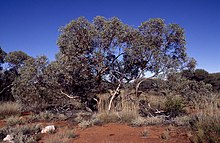
Eucalyptus pleurocarpa, commonly known as tallerack, talyerock or tallerack is a species of mallee that is endemic to the southwest of Western Australia. It has smooth bark, broadly lance-shaped to elliptical, grey or glaucous leaves that are arranged more or less in opposite pairs, flower buds in groups of seven, whitish flowers and glaucous, barrel-shaped fruit. It is easily recognised in the field by its form, large, white, waxy leaves and, when in flower, its stamens clustered in four groups.

Eucalyptus youngiana, commonly known as large-fruited mallee, Ooldea mallee and yarldarlba, is a species of mallee, less commonly a tree, that in native to arid and semi-arid areas of southern Western Australia and South Australia. It has rough, fibrous bark on some or all of the trunk, smooth bark above, lance-shaped adult leaves, flower buds in groups of three, red, pink or bright yellow flowers and short, broad, conical fruit.

Eucalyptus grossa, commonly known as coarse-leaved mallee, is a species of mallee or rarely a straggly tree, that is endemic to Western Australia. It has rough, fibrous bark on the trunk and all but the thinnest branches, broadly lance-shaped to egg-shaped adult leaves, flower buds in groups of seven, yellowish green flowers and cup-shaped to cylindrical fruit.

Eucalyptus viridis, commonly known as the green mallee, is a species of mallee or small tree that is endemic to south-eastern, continental Australia. It has rough fibrous or flaky bark on the lower trunk, smooth bark above, linear to narrow lance-shaped adult leaves, flower buds in groups of seven or nine, white flowers and cup-shaped fruit.

Eucalyptus drummondii, commonly known as Drummond's gum or Drummond's mallee, is a species of mallee or tree that is endemic to the southwest of Western Australia. It has smooth bark, narrow elliptical to egg-shaped adult leaves, flower buds in groups of seven, white flowers and hemispherical fruit.

Eucalyptus wilcoxii, commonly known as Deua gum, is a species of mallee or tree that is endemic to south-eastern New South Wales. It has smooth bark, lance-shaped adult leaves, flower buds in groups of three, white flowers and cup-shaped or bell-shaped fruit.
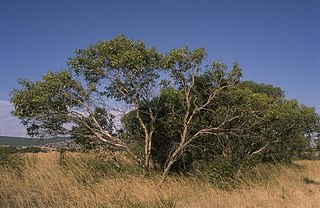
Eucalyptus incrassata, commonly known as the lerp mallee, yellow mallee, ridge fruited mallee or rib fruited mallee, is a species of mallee that is endemic to southern Australia. It has smooth bark, sometimes with rough, ribbony bark near the base, lance-shaped adult leaves, flower buds in groups of seven, creamy white, pale yellow, sometimes pink or red flowers, and cylindrical, barrel-shaped or bell-shaped fruit.
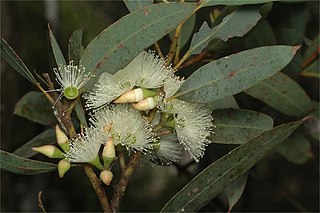
Eucalyptus ligulata, commonly known as Lucky Bay mallee, is a mallee that is native to a few small areas along the south coast of Western Australia. It has smooth bark on the trunk and branches, narrow lance-shaped leaves, flower buds in groups of between nine and thirteen, creamy white flowers and cup-shaped or barrel-shaped fruit with shallow ribs on the sides.

Eucalyptus rigidula, commonly known as stiff-leaved mallee, is a species of mallee that is endemic to Western Australia. It has smooth bark, linear to narrow elliptic or narrow lance-shaped leaves, flower buds in groups of nine or eleven, creamy white flowers and barrel-shaped to hemispherical fruit.

Eucalyptus sporadica, commonly known as the Burngup mallee, is a species of mallee that is endemic to the southwest of Western Australia. It has smooth bark, lance-shaped adult leaves, flower buds in groups of seven, yellowish flowers and down-turned, conical to cylindrical fruit.

Eucalyptus yilgarnensis, commonly known as yorrell or yorrel, is a species of mallee, rarely a small tree, that is endemic to Western Australia. It usually has rough bark on the trunk, smooth bark above, linear to narrow elliptical or narrow lance-shaped adult leaves, flower buds in groups of seven or nine, white flowers and barrel-shaped fruit.
Eucalyptus vokesensis, commonly known as the Vokes Hill mallee, is a species of mallee that is endemic to South Australia. It has rough bark on the lower stems and larger branches, broadly lance-shaped to broadly egg-shaped adult leaves, flower buds in group of nine to thirteen, pale yellow flowers and cup-shaped to barrel-shaped fruit.

Eucalyptus flindersii, commonly known as the South Australian grey mallee, mallee red gum, or grey mallee, is a species of mallee that is endemic to South Australia. It usually has smooth, pinkish grey bark, lance-shaped to curved adult leaves, flower buds in groups of three or seven and conical or hemispherical fruit with the valves protruding.

Eucalyptus cyanophylla, commonly known as the Murraylands mallee, blue-leaved mallee or ghost mallee, is a species of mallee that is endemic to southern Australia. It has mostly smooth bark, greyish blue, lance-shaped or curved adult leaves, flower buds in groups of seven, white flowers and conical, cup-shaped or barrel-shaped fruit.
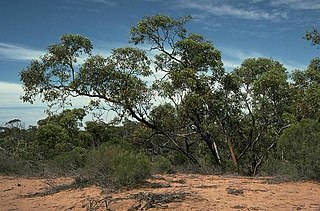
Eucalyptus yumbarrana, commonly known as the Yumbarra mallee is a species of mallee that is endemic to South Australia. It has rough, flaky bark on the lower trunk, smooth bark above, egg-shaped to lance-shaped adult leaves, flower buds in groups of seven, creamy white to yellow flowers and shortened spherical to cup-shaped fruit.
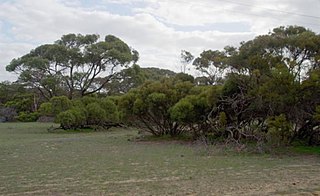
Eucalyptus decipiens, commonly known as redheart or redheart moit is a species of mallee or small tree that is endemic to Western Australia. It has varying amounts of rough, imperfectly shed ribbons of brownish bark and smooth whitish to grey bark, lance-shaped adult leaves, flower buds in groups of between eleven and twenty one, and conical to flattened hemispherical fruit.

Eucalyptus diversifolia, commonly known as the soap mallee, coastal white mallee, South Australian coastal mallee, or coast gum is a species of mallee that is endemic to an area along the southern coast of Australia. It has smooth bark, lance-shaped adult leaves, flower buds in groups of between seven and eleven, white to creamy yellow flowers and cup-shaped fruit.
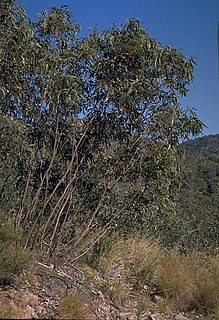
Eucalyptus pumila, commonly known as the Pokolbin mallee, is a species of mallee that is endemic[ to New South Wales. It has smooth bark, lance-shaped to curved or elliptical adult leaves, flower buds in groups of seven, white flowers and hemispherical or cup-shaped fruit.
Eucalyptus minniritchi is a species of multi-stemmed, spreading mallee that is endemic to Central Australia. It has glossy, brown to grey, "minni ritchi" bark on the trunk, elliptical to egg-shaped adult leaves, flower buds mostly in groups of seven, pale creamy yellow flowers and conical to hemispherical fruit.
Eucalyptus notactites, commonly known as southern limestone mallee, is a species of mallee that is endemic to the southwest of Western Australia. It has smooth, greyish bark, lance-shaped adult leaves, flower buds in groups of between eleven and fifteen, creamy white flowers and hemispherical fruit.
